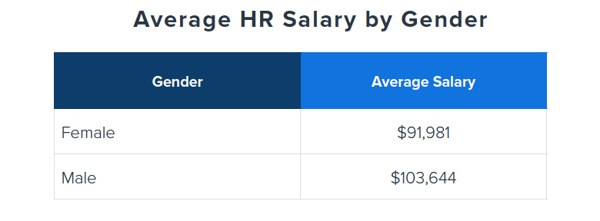
Are Women in HR Paid Fairly?

One of the most pressing issues in HR and employment law is gender pay equity. Across all industries, research shows that women make less than their male colleagues, or 76 cents to the dollar. Because of their influence over employee compensation, it’s often said that HR professionals are best equipped to stomp out the problem.
Is the pot calling the kettle black? Up until now, few have considered whether HR itself has a pay equity problem. In Namely’s HR Careers Report, we looked at our database of over 1,000 companies and 200,000 employees to identify trends in demographics, compensation, and more—specifically for HR practitioners.
Closing the Gap?
According to the report, HR is not exempt from the pay equity issues other industries face. Though the disparities are smaller than the national average, women in HR make, on average, 13 percent less than their male counterparts. For context, 71 percent of HR professionals are women.
There appears to be an age component to the pay gap as well. Though the gap remains narrow when young professionals are compared, it widens significantly at age 45. Why the dramatic shift? Our theory is that this delayed gap reflects a return to the workforce by women who have taken time off to start a family. This so-called “motherhood penalty” has been tied to issues beyond compensation, with one Harvard study finding that returning mothers were 6 times less likely to be hired, and even receive 20 percent lower ratings come review season.
 Source: Namely, HR Careers Report 2019
Source: Namely, HR Careers Report 2019
In addition to looking at how salaries differ by gender, our report also studied how the average HR salary varied by company size, title, and geography. You can learn more about those findings here.
Reason for Optimism
Even though the Equal Pay Act has made pay discrimination illegal since 1963, disparities persist. While HR might be slightly ahead of the curve when it comes to managing its own pay equity (11 percent versus the national 20 percent), any gap is still bad news. Thankfully, with emerging legal and technology trends, there might be reason for optimism.
Local lawmakers are starting to take a novel approach to addressing the pay gap: banning the use of salary history in compensation decisions. The theory behind this approach is that if past disparities can’t be used to determine compensation, and a job’s worth is strictly a preset number, the gap effectively resets.
In 2016, Massachusetts passed the first such ban. Since then, California, Oregon, Delaware, and the cities of Philadelphia, New York, and San Francisco have followed suit. The flurry of legislative activity led many to dub 2017 the “year of equal pay.”
Technology has also made it possible for HR teams to more easily identify pay disparities. Analytics tools have made it possible for employers to readily report on salaries and promotions by gender and ethnicity. Far from simply reporting on traditional HR metrics like turnover, modern day teams are watching metrics like pay equity, employee Net Promoter Score, and career path ratio. These tools, coupled with the rise of salary benchmarking services that give job applicants and sitting employees a sense of their actual worth, suggests technology could play a pivotal role in closing the gap.
Those are just some of the findings in Namely’s new HR Careers Report 2019. Think you know HR? Read the full report on HR demographics, titles, salaries, and more by clicking below.

See how Namely's flexible solution will help you streamline your HR processes by having your people, payroll, and benefits info all in on place.
Get a demoYou May Also Like
Get the latest news from Namely about HR, Payroll, and Benefits.
Thanks for subscribing!


Get the latest news from Namely about HR, Payroll, and Benefits.
Thanks for subscribing!



